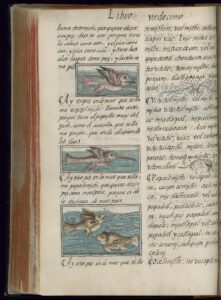
Bird, Hummingbird, Butterfly and Jaguar-fish of the Florentine Codex, “On Earthly Things”, Ms. Mediceo Palatino 220, 1577, fol. 62v. Courtesy of the Biblioteca Medicea Laurenziana, Florence, and by permission of MiBACT
The Florentine Codex is an encyclopedic manuscript produced collaboratively by the Franciscan friar Bernardino de Sahagún and a team of indigenous writers and artists. It was completed at the Colegio de Santa Cruz de Tlatelolco in Mexico City in 1577. Renowned for its bilingual presentation of Pre-Hispanic indigenous culture and the Spanish conquest of the Aztec Empire, the codex’s twelve books comprise a primary Nahuatl text (an indigenous language of central Mexico), a Spanish interpretation of the Nahuatl text by Sahagún, and thousands of illustrations painted by Nahua artists. Together the alphabetic texts and the images form three parallel narratives. Today, the codex is considered the most reliable source of information about central Mexican culture.
Using different examples from books 10 and 11, respectively devoted to the “people” and to animals, plants, and stones of ancient Mexico, the lecture will explore how the codex’s encyclopedic content was collected using questionnaires and how the editorial process, including translations, summaries, and additions, shaped meaning. Particular attention will be paid to the role played by the painters (tlahcuilohqueh) who employed different strategies to visualize the collected data.
About the speaker
Dr. Bérénice Gaillemin is an art historian and ethnologist, specialized in the study of colonial Nahua Catholic texts, both alphabetical and pictorial. She obtained her PhD in ethnology at the University of Paris Ouest Nanterre and contributes since 2020 to the Florentine Codex Initiative (Getty Research Institute).

